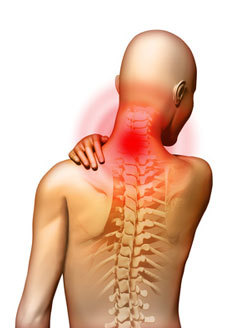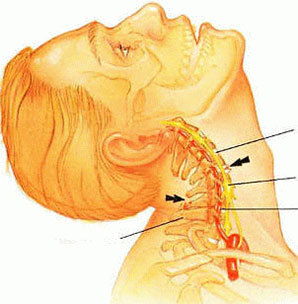Cervical osteochondrosis is a lesion of the vertebral discs of the cervical spine, as a result of which they undergo degenerative-dystrophic changes. The main reason for its development is a violation of the normal course of metabolic processes, which leads to a distortion of the structure of the vertebral bodies and cartilaginous discs. In the case of localization in the neck, the symptoms of the pathology are largely determined by the compression of large vessels. Treatment methods are selected based on the stage, the specificity of the course, the severity and the main symptoms.
Characteristics of the disease
The cervical form is the most dangerous type of osteochondrosis: it leads to impaired cerebral circulation, since the vertebral artery passes through this area, one of the largest vessels supplying the brain with necessary substances andthe Oxigen.
Displacement of the vertebrae, abnormal changes, and overgrowth of bone and fibrous tissue disrupt normal vessel function.
The specificity of the symptoms of osteochondrosis in this part is determined, among other things, by one of the structural characteristics of the cervical vertebrae, which consists in their greater adherence to each other. As a result, any change in one segment causes the failure of the entire department.
Clinic according to stage
In the process of its development, cervical osteochondrosis goes through four stages. How does it manifest itself in each of them?
- Stage 1. It is characterized by the appearance of initial alterations in the stability of the intervertebral discs. Symptoms are mild or absent. Mild pain sensations and local muscle tension are possible.
- Stage 2. The disc bulge begins, the spaces between the vertebrae are reduced, the fibrous ring collapses. In many cases, as a result of compression of the nerve endings, pain appears, mainly of a specific nature. They intensify when turning, tilting the neck. The tone decreases, weakness often appears.
- Stage 3. The final destruction process of the annulus fibrosus leads to the formation of hernias. This stage is characterized by a significant deformation of the spine. Increased pain and fatigue occurs against the background of sensory disturbances and limited mobility in the affected area.
- Stage 4 is the most difficult. The severe pain syndrome manifests itself with any attempt at movement, which leads to a significant limitation of the mobility of this department. Sometimes the pain subsides, but this does not show an improvement in the condition, it only indicates an increase in the size of the bone growths that significantly limits movement. They often lead to the disability of the patient.

Symptoms of cervical osteochondrosis
When in the cervical spine, the predominant symptoms of osteochondrosis are:
- pain in the neck, back of the head, shoulder, arms;
- restriction of movement, crunching in various turns, neck tilt;
- weakness in the hands;
- drawing pain in the left side of the chest, radiating to the corresponding arm;
- burning in the interscapular zone;
- recurring headaches;
- weakness;
- dizziness (with a severe course of cervical osteochondrosis, you can become unconscious);
- coordination of movements is impaired, which is mainly reflected in gait;
- hearing impairment, ringing in the ears;
- decreased vision;
- sore throat;
- poor dental health;
- weakening or hoarseness of the voice;
- snoring is a consequence of tension in the neck muscles.
In the cervicothoracic type, the symptoms are almost similar to those of cervical osteochondrosis. This:
- asthenic syndrome;
- dizziness and headaches;
- periodic pressure fluctuations;
- flies flashing before eyes;
- pain in the shoulder girdle and arms;
- muscle weakness;
- numbness, tingling, coldness of the fingers;
- chest pain, heart area;
- nausea;
- numbness of the tongue, face;
- dental problems;
- sensation of current flowing through the arms when trying to bend the neck.
Syndromes
The symptoms of cervical osteochondrosis are not considered typical. Which of them are more pronounced largely depends on the specific goal. Many of the manifestations can be mistakenly associated with other pathological conditions. Therefore, there are often cases when the wrong treatment is prescribed.
The symptom complex is divided into the following groups:
- root;
- vertebral artery syndrome;
- irritant reflex syndrome.
Root syndrome
- chill feeling;
- tingling in hand, forearm, fingers;
- pasty.
Manifestations also vary depending on the area of injury. If the endings of the central nerve are affected, the dough extends to the thumb, middle and index fingers. When the brachial nerve endings are pinched, the little finger and ring finger are affected.
Irritant reflex syndrome
A sharp, burning pain in the cervico-occipital region, which appears during movement after a static state: after sleeping, when sneezing, a sharp turn of the head becomes its sign. The pain often radiates to the shoulder and chest.
Vertebral artery syndrome
The symptoms of cervical osteochondrosis become:
- stabbing or burning headache (paroxysmal or persistent), extending to the temporal region, crown, back of head, and eyebrows;
- increased discomfort with certain movements or after a long time in an uncomfortable position;
- general weakness;
- nausea;
- loss of consciousness;
- hearing problems;
- vestibular apparatus disorders;
- eye pain;
- blurred vision.
Cardiac syndrome
With the appearance of this complex of symptoms of osteochondrosis of the neck, an almost similar picture of angina develops, which often leads to wrong treatment.
Muscle contractions and spasms in the heart region are probably a reflex response to compression of nerve endings in the lower cervical region. Cardiac syndrome is a consequence of irritation of the phrenic nerve (its fibers lead to the pericardium) or the pectoralis major muscle:
- the pains appear suddenly, last a long time;
- aggravated by jerky neck movement, coughing, sneezing;
- tachycardia and extrasystole are possible;
- pain does not stop after taking coronary dilators;
- there are no signs of impaired circulation on the ECG.

Exacerbation of the disease
In the exacerbation stage, the symptoms of cervical osteochondrosis are:
- increased pain and its radiation to the scapula, interscapular area, arms, shoulders;
- Difficulty in movement of the shoulders, torso, arms, sometimes breathing (inhalation and exhalation);
- pain syndrome often resembles a heart attack or intercostal neuralgia;
- when pain appears in the right upper quadrant or in the iliac area, the symptoms are similar to the manifestations of gastritis or cholecystitis;
- headaches are prolonged in nature, imbalance, visual and auditory functions are impaired;
- in the zone of innervation, the trophicity of the skin is disturbed, tingling, numbness, dryness, paleness, burning, coldness appears;
- increases the tone of the cervical muscles;
- appear weakness, lethargy, nervous tension, anxiety, emotional instability;
- possible sleep disturbances, memory disturbances and concentration problems.
Osteochondrosis and vegetative-vascular dystonia
Cervical osteochondrosis can cause a subluxation of the first cervical vertebra with displacement to the right or to the left, leading to the development of VSD (vegetative vascular dystonia). It is quite difficult to identify it, since many times there are no symptoms or they are mild. In this case, it is possible:
- compression of the sympathetic nerve plexuses, leading to the appearance of neurological signs or VSD;
- compression of arteries and deterioration of cerebral circulation;
- compression of the veins, causing a violation of blood outflow and a subsequent jump in intracranial pressure;
- compression of the spinal cord, causing impaired movement of cerebrospinal fluid, which also results in high pressure within the skull;
- Muscle spasm that aggravates symptoms as a result of severe compression of blood vessels and nerves.
The resulting processes are:
- headaches;
- darkening in the eyes;
- dizziness;
- impaired visual acuity;
- double vision (diplopia);
- blinking before the eyes of "flies";
- high or low pressure;
- nausea, sometimes with vomiting;
- loss of consciousness.
Vertebral subluxation is detected by X-ray. Its reduction is a rather complicated procedure, usually performed under general anesthesia.
How the disease is diagnosed
The main methods for diagnosing cervical osteochondrosis are:
- radiography;
- magnetic resonance imaging;
- computed tomography;
- Doppler ultrasound;
- duplex scan.
The last two methods are used to check the status of the neck vessels.



































